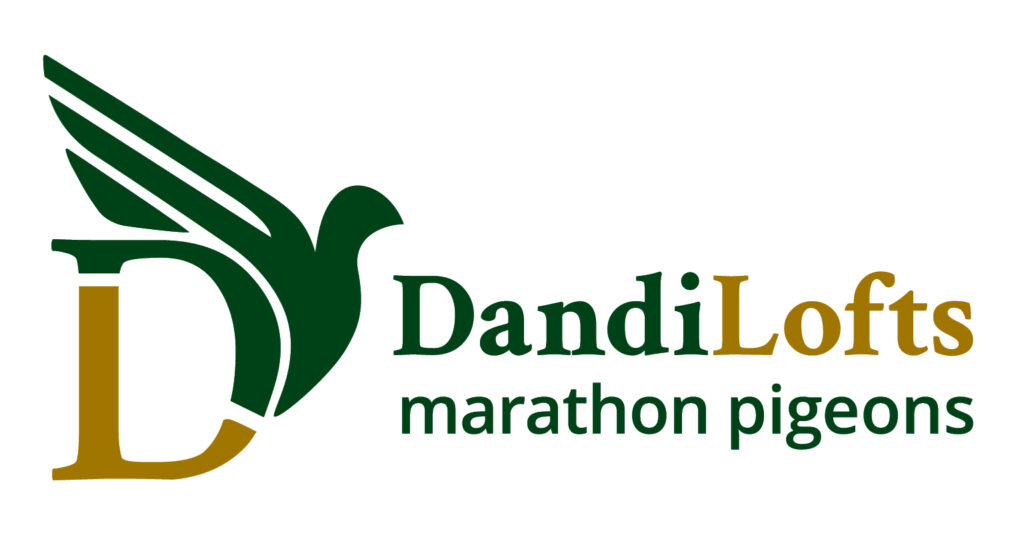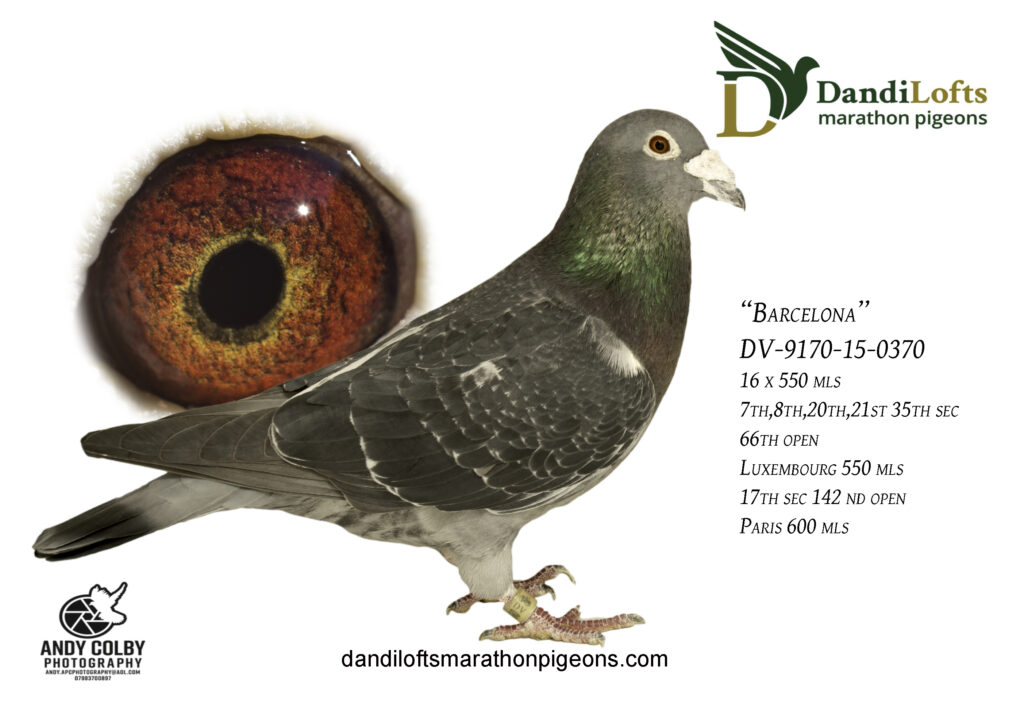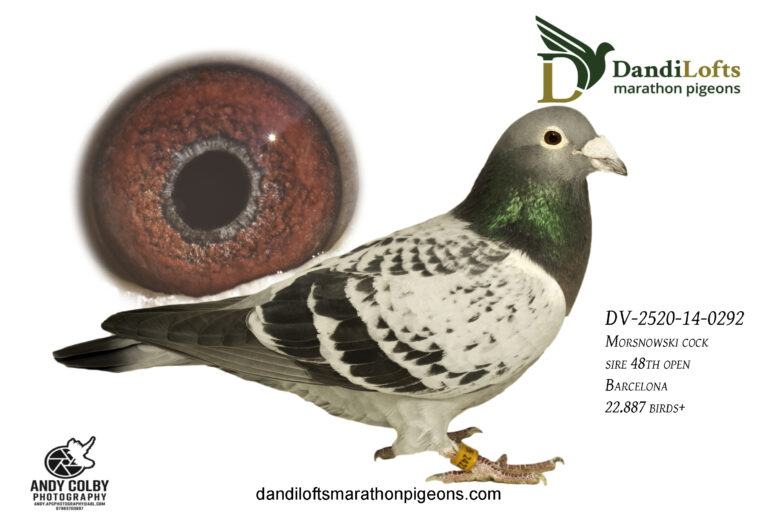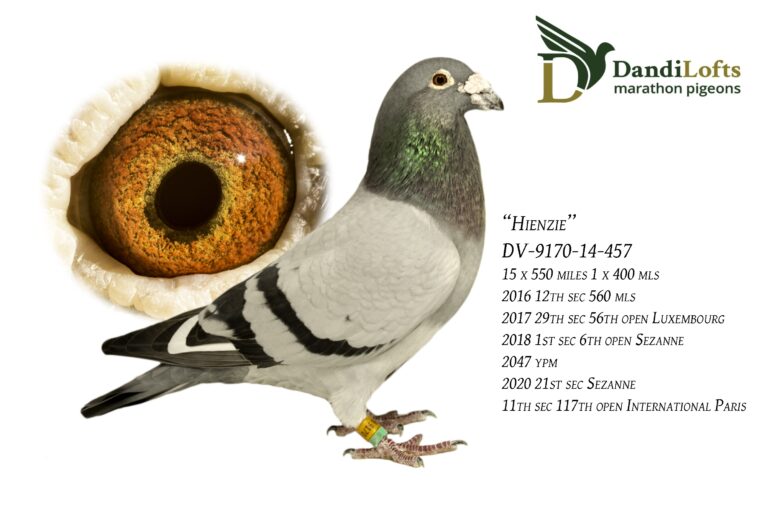
The Barcelona Cock and two son's now at Dandilofts UK

The Quality at Dandilofts UK
The Hermann Zgoll Cock now at Dandilofts UK After a loan spell at Safe Haven Lofts
The Heinzie DV9170 14 457 One of the Fastest Sect wins ever! Dandilofts 550 Mile Distance Sprinter


News and Information
Part1 - NOV / DEC 2020 - Autumn time to reflect and make the difference for next year.
It is the end of another long season, it is time now to contemplate and reflect on the season , what worked well , and what needs to be improved upon for next year, In order to give our team at least a fighting chance to reach home in a respectable time. One of the first aspects to realise is that the faults of nearly all the not so good races lies one and alone with YOU. This is the one point that most racing pigeon men or women don’t or won’t accept. For them it is always the fault of the Rain, the Wind, “The Liberation was too early”, or ” I live too far west or east”.
However, in my opinion in 99% of cases it’s our own mistakes or our own laziness or in some cases the lack of knowledge which leads to the outcome of races that do not meet up to our own expectations and in the worst case scenarios can lead to some big losses.
What we do now for our birds will influence their results and their performances next year. How deep we delve into the problems now will determine how much we improve next year. After all, never forget “after’’ the season is also ‘’before’’ the next season!
The area's to consider are:
The Loft - Race Preparation - Overall Health - Breeding - Motivation - System
The Loft:
This is the time to think hard about how your loft has worked for you and your racing system. Do you need to tweak your race system or does the loft need modifying in some way ?
For me this year is a little bit more complicated than it would normally be, as two years ago I built a new loft for the start of racing and on reflection at the end of last season I realised that it really needed to be slightly modified.
Race Preparation:
There were a few thing that had given me difficulty during race preparation and indeed on basketing nights, although in general the loft had worked really well including the ventilation , trapping feeding and cleaning, and the birds were in great condition the whole season, What was not optimal was the positioning of the hen compartments although they were then only a few yards away from the cocks when I wanted to show the hens to the cocks I had to basket the them and carry them over to the widowhood section , and in my opinion this created to much stress on the hens (as well as myself).
So I have changed to a better layout where each cock section has the hen section adjoining it and therefore I could use the roundabout system (through adjoining hatches) which in my opinion is the best method for keeping both sexes fit and motivated.
This year it was full steam ahead with the new layout and wow did it work well . So I am here at the end of the season looking at the loft again and how it can be improved just a little to move me nearer to my goals for next year.
I have decided that the distance loft is perfect just the way it is, However the yearlings loft has not performed to the standard required, ie: 6 weeks of top results and then as the hot weather arrived the form just dropped off, showing me that the lofts was heating up too much during the daylight hours and the ventilation was not optimal to hold the birds top form. Therefore the decision is a new loft must be built and that means planning and building over the autumn , so as it seems I have my work cut out for me for the rest of the year.
With the changes and decisions made and the lofts all disinfected it is time to move the birds in for the winter months which will allow them to claim their boxes and settle down before the next season. I keep all the yearlings so it’s a straight forward job to put them in the new section, I spend a good 10 days in the loft with the birds ensuring they are well settled in and none of them get bullied by the dominant cocks.
Overall Health:
Given that the birds have performed well this should be an easy task with the requirement just to get a vet to do an end of season check up. If however the performances were not up to the standard that you require, it may be ( more than likely ) traced back to the birds not being completely healthy, which in turn would normally mean that the birds are or were infected with one or more of the pigeon diseases, the symptoms of which were missed by YOU or your VET.
The solution to the health question is very personal as we all have our own thoughts as to how to prepare the birds for the coming season. My personal thoughts are never treat until you know for sure what you have to treat for. I would not say ‘never use antibiotics’ but (and its a big but)“ use the correct ones”. Easier said than done!
I have had a stroke of luck and found a Lab where my birds can be tested for diseases and also for resistance against antibiotics. So I will be told from the lab what my team has and which medicines they need and for how long they must take them. Not that over the past 3 years I have had to give any antibiotics.
The health of the birds is due in the most part to the environment that they are held in, their access to the skies, as well as the food and supplements they are given on a daily basis.
In my opinion and this will more than likely cause a controversial talking point amongst the Fancy, (but here goes anyway)…
Plain water is a breeding ground for many different pigeon illnesses to be spread around and therefore my birds always have something in the water the whole year round. Up until three years ago I used apple cider vinegar or Avidress and they were both doing the job of keeping the spread of sickness at bay (I think). However, 3 years ago I found a product that I find to be the best water supplement around. I am not promoting this product. It’s just in order as they say to tell the truth the whole truth and nothing less, I need to mention it . It’s called Kuhn Brieftauben Tonikum. It is really expensive but I could not envisage my birds racing so well and staying so healthy without it, a few drops everyday in the water and they always look the part.
Also See part 2 Below , when I will be highlighting the following:
Breeding , Motivation and the System as used at Dandilofts Marathon Pigeons.
December 2020 - Autumn time to reflect and make the difference for next year...
Overall Health:
Part 2
Breeding:
The first step to a successful breeding season is the preparation of the birds and the loft , Both are important as part of the breeding season however the health of your birds is paramount at this time for future generations of racing birds within the loft as this has a direct influence on the race results for years to come. Without solid healthy foundations the breeding programme could and probably would fail or , at worst only produce a generation of mediocre racing birds failing to produce the results that I expect to achieve as well as taking up valuable space within the loft that could have housed a champion .
So all the birds have to be tested by a laboratory and subsequently treated for whatever they were diagnosed with ,this is in many cases not possible to do due to having no access to a local laboratory and so many have no alternative as to treat blind in order to achieve a minimal level of health within the loft but the facts remain if you do not or can not test them you can never be 100% satisfied that the pigeons are 100% healthy . The blanket administering of antibiotics is not ideal and in my opinion aiding in the large amount of losses .
So at this point now I am sure that the team of birds that I have are healthy ,and the first stage of selection of the pairs can begin. I find that winter is a great time to do this as there is more time to contemplate the many variables that go into these very important decisions.
“The following is a list of what I consider when making the pairing lists for the upcoming breeding season”
The parentage
Where in your strain does the bird fit? has it been newly crossed? or is it inbred/outbred or a strain founder or fixed point in the strain? also what has this bird produced in previous breeding seasons ,maybe a son or daughter maybe a grandson that in turn has produced a winner or a regular placing in the top spots. This is when, good record keeping is essential after all we are all getting older and the old gray matter can let you down sometimes but pen and paper (or a computer) tells the story with accuracy. It is a stage for much deliberation and lots of frustration ,I must change the pairing at least 4
times before I am happy with them and go to print.
Anatomy
How is the bird in the hand? This will tend to be a personal preference as I think we all have our own ideal build or way the bird should feel when in the hand. I am one that leans toward a small but firm body with a tight vent and a flat breast bone that is obscured by the muscle to give the bird a round feel.
I think it was Hans Eijerkamp that said “ you can feel the harmony of the pigeon and that it vibrates in the hand” (when in form).I would prefer to say it’s the balance of the bird laying well in the hands, it just feels right .
The wings
You could write a book with all the theories there are out the about how a wing should be for long distance or sprint etc etc .The only thing I like to see is that the last 3 flight feathers are well spaced and of the same length, this is not something that is found often but in my experience this wing is a great long distance wing with a of potential to cover the marathon distance up to 1,000 miles ,this is also why it is so rare, in my opinion.
The Eye
I am not going to get into in any way shape or form, I like a bright clear eye in which you can see the vitality and character of the pigeon, any other observations are for the theorists to decipher.
The feathers
These are also important but I have found that the feathers will be good if they get all the vitamins and minerals they require as well as access to regular baths. A nice silky feel and full body feathers is the look you should be achieving if not maybe it shouldn’t be bred from?
Performances
Here we go the most important part of the selection process but also the easiest .The best bird gets paired together with the 2nd best bird ,providing that all the above criteria have been satisfied, this part is not rocket science. The apple never falls far from the tree, that’s why we should always try to stay as close to the tree as possible ,until such time as the tree has produced another tree. Some of the later born offspring will be better than the original which makes full sense as the times and conditions have also changed and developed the new generations are bred to cope. With the new situation like 5G or the change in the earth’s magnetic field’s or even YB sickness
Age
Not wishing to be branded an ageist breeder, but the vitality of a 12 year old bird is not the same as a 2 year old, so just looking to ensure you keep the young with the old can produce some great offspring full of vitality and racing spirit, after all a young Hen will tend to keep even the oldest of cocks on his toes and may help him filling his eggs and vice versa.
Pairing the birds for breeding
Having now selected the pairing on paper I like to do a test pairing but before I can do this I have to prepare the lofts,this is the not as I have explained in part one with rebuilding and and the such like it’s the moving of the different birds to there new sections. I have or will have the following sections distance cocks, the sprint cocks new to Dandilofts in 2021 and the yearling cocks. Then the same for hens each adjoining the cocks sections.
I like to pair the birds for 3 or 4 days in their new boxes and sections and then train them on the roundabout. Some are very stubborn and don’t like moving from there old section but I persevere they will get it eventually .Two days training with the cocks and most birds will have settled in so now the cocks have the boxes during the day and the hens during the evening and overnight, just for a couple of weeks ensuring the two don’t meet, then the breeding season can begin .
The start of the season is very soon upon me and it starts for the race birds with the pairing up at the end of February, my first race being the first weekend in May .The birds are now not only breeding but also learning what is going to be expected from them for the rest of the season. The best way to get this across is to run through what actually happens.
While sitting on the eggs the cocks and hens are let out once a day just to get a bit of exercise and to keep the BOP aware at the forefront of there thinking of course this is a risk but if I was to keep them in the first few times I let them out again the losses would be very a catastrophic as they wouldn’t be attuned to the danger. So to that my birds are out the whole winter and the complete breeding period. When the young birds are 14 days old the hens are put into their own section during the day let out at about 3:30 pm to fly while the cocks are then driven into the hen section, this is the true start of the roundabout system which you can read about in the article Dandilofts Marathon Pigeons The System
Motivation
Here we have a subject that is open ended with unending variables on the same theme i.e.: the motivation of our feathered friends .What is a safe bet is that as a racing pigeon trainer it is my responsibility to ensure that I get the best out of the birds in any situation
At every distance and in order for me to achieve this I have to be in touch with each and every bird in my loft. They are after all in my opinion all individuals and so can be better motivated by treating them on their own merit .
I am a pigeon crazy person as many of you reading this will also be. I spend hours and hours in the lofts not just watching the birds but talking to them and enjoying their company. Now many of you will be laughing but I find that the birds respond well to this interaction and indeed thrive on it.
I will discuss the mistakes made in the last race. I will praise the team or indeed individuals when they have raced well. Having the birds all on the roundabout the motivation on the distance races is 24 hours with the partner before I basket them for the race but with some little tricks like putting a second hen in the box with an aggressive hen can produce some great results. Just be careful a hen fight can be more deadly than the cocks.
Another trick for the cocks is for a white cock to be put in the box before the box owner comes back in ,as this will send the territorial instinct from the cocks into overdrive ,but once again be careful. The white cock can not live in the section with them as he will be under constant attack.
This is an insight into the way I at Dandilofts prepare and select my birds for breeding as well as the few little things that can be done to motivate the birds to Race up-to 1,000 miles. At the end of the day you have to have the base birds containing the correct genes in order to breed top birds that will race at the distances you want them to.
For new starters and those that are struggling to get to where they want to be I would suggest you go to the best loft you can to source the best birds for the distance you want to achieve two top birds to start with is better than 10 mediocre birds that will just hold you back.
‘’Many thanks for reading this information and good luck ! ’’